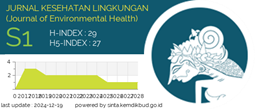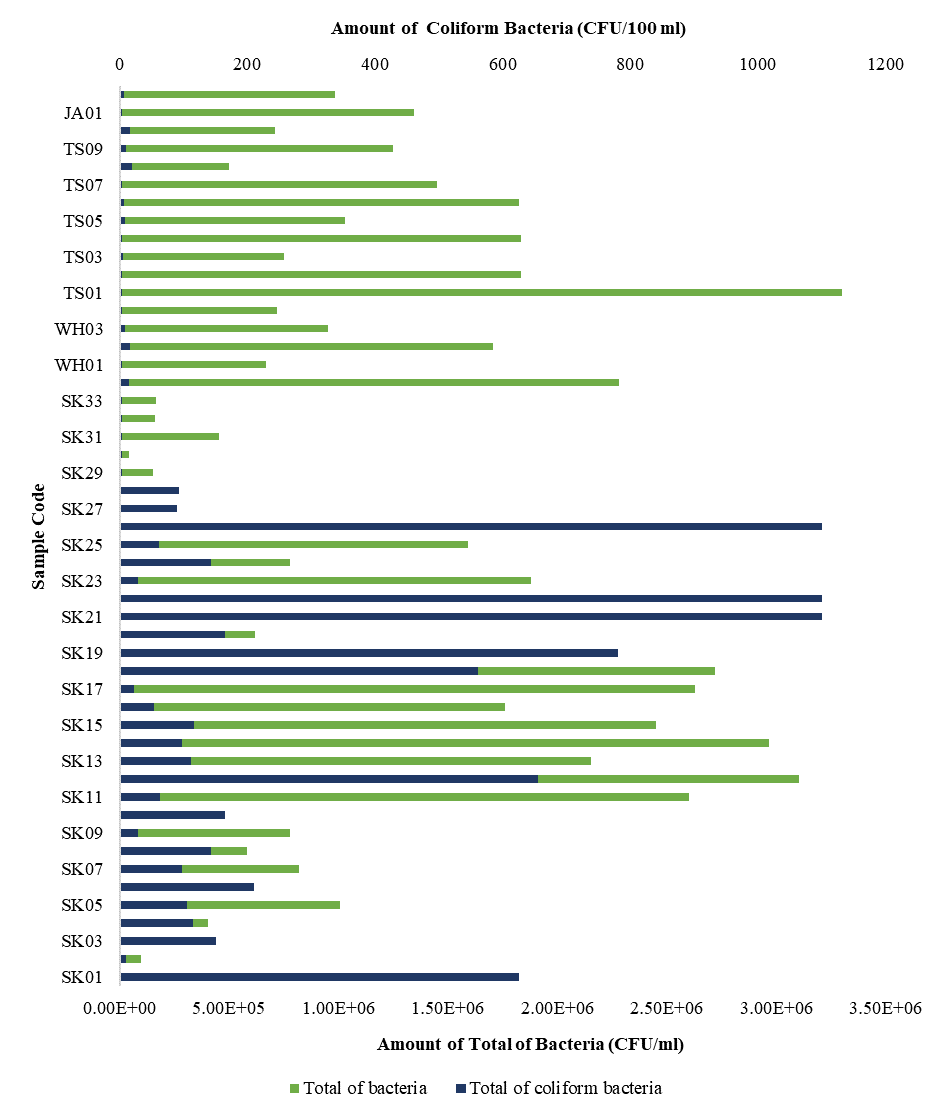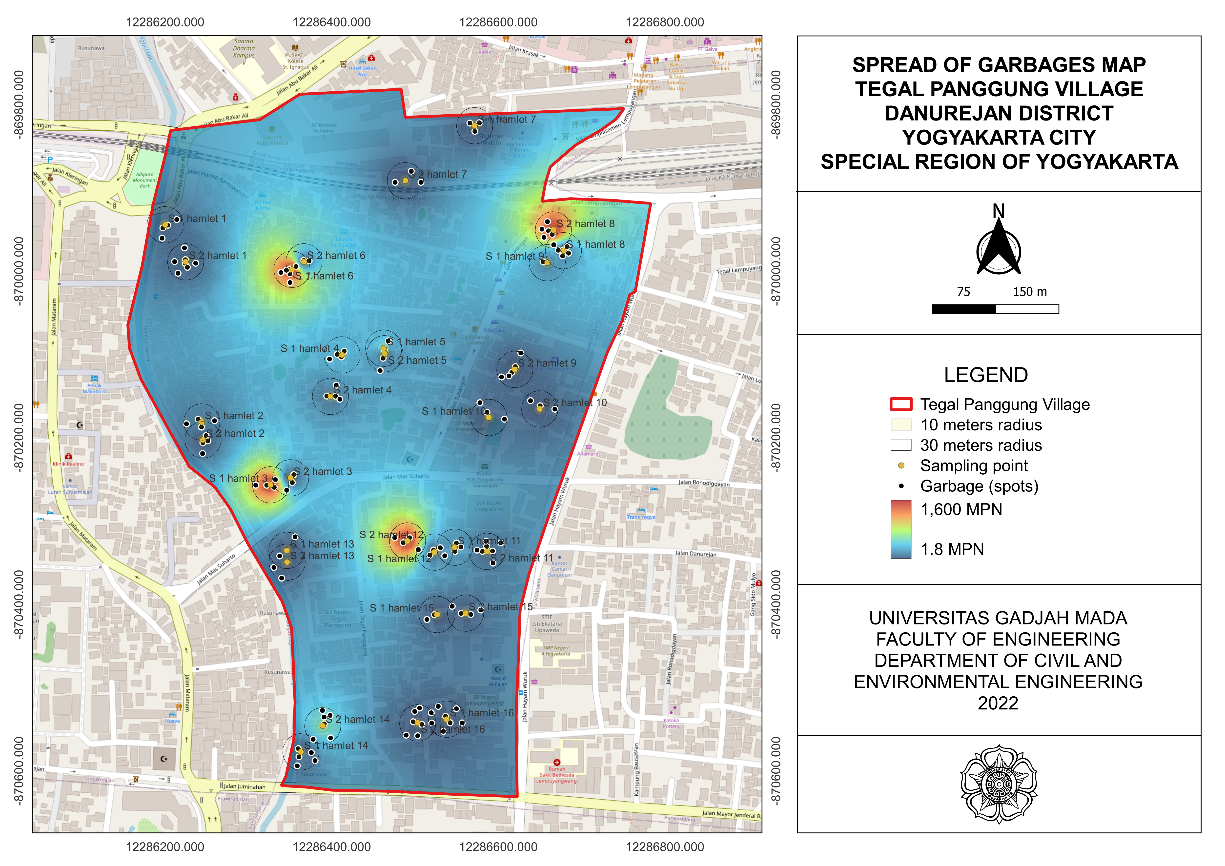Hygiene and Sanitation at Bubur Harisah in Gresik Regency
Downloads
Food is a basic human need that must be fulfilled every day. Food preparation and serving should be done with appropriate processing so that the food can be utilized by the human body. Bubur Harisah is a special food of Gresik Regency which be sought after by people because of its health benefits. The research was conducted to identify the condition of hygiene and sanitation and the quality of Eschericia coli bacteria in bubur harisah based on Permenkes RI Nomor 1096 Tahun 2011 tentang Higiene Sanitasi Jasaboga. The research was done by observational method and cross sectional research design. The sample of the research was taken by non probability as 8 porridge harisah seller in Gresik Regency. Data collection was done by filling out questionnaires, observations, and laboratory tests. The result of the assessment of the hygiene and sanitation condition in bubur harisah that there are 4 sellers (50%) who did not fulfill the test of physical condition of hygiene and sanitation with percentage below 93%. There is 1 seller (12.5%) with positive sample test of bacteria Escherichia coli. Observation results test of physical condition show that condition of hygiene and sanitation of porridge harisah have not fulfill standard. The conclusion of this study is that there was bacteria Escherichia coli in the sample of bubur harisah.The suggestion for this research is that food traders should improve hygiene and sanitation conditions and conduct food handler training which is further supervised and supervised by the health office of Gresik Regency.
Arisman. (2009). Keracunan Makanan. Jakarta: Kedokteran EGC.
Aulia, R. 2015. Studi Tentang Sajian Bubur Harisah Sebagai Makanan Khas Haul Mbah Sholih Tsani Di Pondok Pesantren Qomaruddin Sampurnan Bungah Gresik. Skripsi. Surabaya: Universitas Negeri Surabaya.
BPOM RI. (2016). Sentra Informasi Keracunan Nasional. http://ik.pom.go.id/v2016/ diakses tanggal 17 April 2017 pukul 21.23
Budiyono, dkk. (2008). Tingkat Pengetahuan dan Praktik Penjamah Makanan Tentang Hygiene dan Sanitasi Makanan pada Warung Makan di Tembalang Kota Semarang Tahun 2008. Fakultas Kesehatan Masyarakat UNDIP Semarang http://ejournal.undip.ac.id/index.php/jpki/article/download/2411/2136 diakses tanggal 25 November 2017 pukul 14.10
Cahyaningsih, C., Kushadiwijaya, H.,& Tholib, A. (2009). Hubungan Higiene Sanitasi dan Perilaku Penjamah Makanan dengan Kualitas Bakteriologis Peralatan Makan di Warung Makan. Berita Kedokteran Masyarakat 25(4) 180-188. http://journal.ugm.ac.id/ diakses tanggal 28 November pukul 16.02
Candra, B. (2006). Pengantar Kesehatan Lingkungan. Jakarta : Kedokteran EGC.
Depkes RI. (2004). Higiene Sanitasi Makanan dan Minuman. Jakarta: Ditjen PPM
Dinkes Prop Jatim. (2013). Profil Kesehatan Provinsi Jawa Timur.
Hobbs, Betty, C. (2007). Food Poisoning and Food Hygiene. 7th ed. [e-book] London: Edward Arnold (Publishers) Ltd. https://lib.gen.rus.ec
Karina, S., dkk. (2016). Penerapan Higiene Sanitasi Jasa Boga Pada Katering Golongan A2 dan Golongan A3 di Kota Palangka Raya Provinsi Kalimantan Tengah. Surabaya: Jurnal Media Gizi Indonesia
Karyantina, M. (2007). Industri Jasa Boga. Buku Pegangan Kuliah. Universitas Slamet Riyadi Surakarta merkuri akar yantina.files.wordpress.com/2010/04/industri-jasa-bogal/ diakses tanggal 28 November 2017 pukul 16.18
Marriot. (2006). Principles of Food Sanitation. Fifth Ed, Amerika: Springer Sciences Busines Media Publisher : 83 – 98.
Mukono, H.J. (2008). Prinsip Dasar Kesehatan Lingkungan Edisi Ke Dua. Surabaya Airlangga University Press
Noerhayati, (2008). Sanitasi Hygiene. http://noerhayati.wordpress.com/sanitasi
Laura, R., Radke, V., et al., 2007. Factor Related to Food Worker Hand Hygiene Practices. Journal Of Food Protection. Volume 70: 661-666.
Ismail, R. (2010). Patogenesis Infeksi Bakteri Escherichia coli. http/rismanismail2.wordpress.com/2010/12/13/patogenesis-infeksi-bakteri-e-coli/ diakses tanggal 4 Januari 2018 pukul 19.20
Rahardian,D. (2008). Sanitasi Pondok dan Higiene Perorangan di Pondok Pesantren Putri KH. A.W.Hasyim Kecamatan Bangil, Pasuruan. Surabaya: Departemen Kesehatan Lingkungan FKM Unair : 8-13.
Waluyo, L. (2007). Mikrobiologi Umum. Malang : UMM Press.
WHO. (2005). Penyakit Bawaan Makanan: Fokus Pendidikan Kesehatan. Jakarta : EGC
WHO. (2015). Media Centre. http://www.who.int/mediacentre/news/releases/2015/foodborne-disease-estimates/en/ diakses tanggal 16 Mei 2017 pukul 22.10
Yulia. (2014). Higiene Sanitasi Makanan, Minuman Dan Sarana Sanitasi Terhadap Angka Kuman Peralatan Makan Dan Minum Pada Kantin. Pontianak: Jurnal Kesehatan Lingkungan Poltekkes Kemenkes Pontianak
Yunus, S., Umboh, J., & Pinontoan, O. (2015). Relationship Personal Hygiene and Sanitation Facilities with Escherichia Coli Contamination Food in Padang Restaurant in Manado and Bitung City. Artikel Penelitian. Manado: Dinas Kesehatan Provinsi Sulawesi Utara.
2. Formal legal provisions to access digital articles of electronic journal are subject to the provision of the Creative Commons Attribution-ShareAlike license (CC BY-NC-SA), which means that Jurnal Kesehatan Lingkungan is rightful to keep, transfer media/format, manage in the form of databases, maintain, and publish articles.
3. Published manuscripts both printed and electronic are open access for educational, research, and library purposes. Additionally, the editorial board is not responsible for any violations of copyright law.
JKESLING by UNAIR is licensed under a Creative Commons Attribution-ShareAlike 4.0 International License.







































